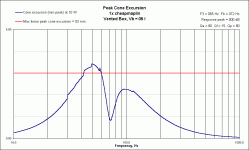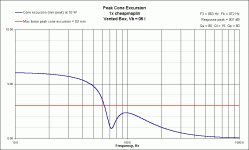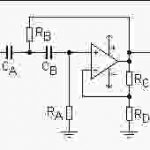Hmm......
If I understand that circuit correctly the op-amp
adds the input and the feedback voltage together.
Seems to me using shunt instead of series feedback
you should be able to arrange omitting the op-amp.
Is this possible ?
(i'd also slap a coil across the 0.5R output resistor)
 /sreten.
/sreten.
If I understand that circuit correctly the op-amp
adds the input and the feedback voltage together.
Seems to me using shunt instead of series feedback
you should be able to arrange omitting the op-amp.
Is this possible ?
(i'd also slap a coil across the 0.5R output resistor)
The circuit has got positive current feedback and also conventional negative voltage feedback. The positive current feedback gives the negative output resistance. The positive feedback is rolled off at high frequencies and the negative feedback reduced at high frequencies to keep the overall gain constant. This lot is difficult to achieve with one amp!
The circuit given will have a slight DC offset so R26 should go to the negative end of C16 to avoid this (the positive feedback being then AC coupled).
The overall gain of this is lower than the original so I plan to have a small amount of gain in the high pass filter
By the way the 0.11ohm resistors are two 0.22 in parallel so the overall current monitoring resistor is four 0.22 in parallel. I aim to use a 0.05 ohm chip resistor for the final version.
I will have to remove the 0.5 ohm in series with the output on the original hoping I can get away without an output inductor.
A couple of pics showing the excursion reduction with the HPF
The circuit given will have a slight DC offset so R26 should go to the negative end of C16 to avoid this (the positive feedback being then AC coupled).
The overall gain of this is lower than the original so I plan to have a small amount of gain in the high pass filter
By the way the 0.11ohm resistors are two 0.22 in parallel so the overall current monitoring resistor is four 0.22 in parallel. I aim to use a 0.05 ohm chip resistor for the final version.
I will have to remove the 0.5 ohm in series with the output on the original hoping I can get away without an output inductor.
A couple of pics showing the excursion reduction with the HPF
Attachments
I have finished reworking the Microlabs. Its extensive, fiddly, time-consuming but the result is worth it IMO
Its spooky hearing the bass and yet the cone is hardly moving. The port is doing most of the work, the negative resistance seems to make the port work really well.
I ended up using 910 ohm for R29 to allow for the 0.05 ohm current monitoring resistor instead of the 0.055 in the prototype.
The filter which goes after the volume control ( see jpg) is Ca, Cb 0.22uF, Ra 12k, Rb 16k Rc, Rd 6.2k
Please e-mail me if you want more detailed instructions on how do do the rework Only experienced people should tackle this and you need access to a scope if things dont work.
Its spooky hearing the bass and yet the cone is hardly moving. The port is doing most of the work, the negative resistance seems to make the port work really well.
I ended up using 910 ohm for R29 to allow for the 0.05 ohm current monitoring resistor instead of the 0.055 in the prototype.
The filter which goes after the volume control ( see jpg) is Ca, Cb 0.22uF, Ra 12k, Rb 16k Rc, Rd 6.2k
Please e-mail me if you want more detailed instructions on how do do the rework Only experienced people should tackle this and you need access to a scope if things dont work.
Attachments
Great work guys!
Thanks for measurements Vikash, and for all efforts from Conssort and Sreten. Looks like a fun project.
I wanted to make monitors for pc, but i really couldn't build such cheap ones as this, so it's maybe better to modify these.
They look really attractive at this price (28e here). I would probably buy them soon, and put another 2030a amps for tweeters, with active linkwitz-riley crossover, notch filters, new torus transformer, and new tweeters (titanium domes for 6e piece, just to try them).
Can somebody give me more detail about their sound, are they really a good buy. (before and after modifying)
Thanks
Thanks for measurements Vikash, and for all efforts from Conssort and Sreten. Looks like a fun project.
I wanted to make monitors for pc, but i really couldn't build such cheap ones as this, so it's maybe better to modify these.
They look really attractive at this price (28e here). I would probably buy them soon, and put another 2030a amps for tweeters, with active linkwitz-riley crossover, notch filters, new torus transformer, and new tweeters (titanium domes for 6e piece, just to try them).
Can somebody give me more detail about their sound, are they really a good buy. (before and after modifying)
Thanks
Hi,
sorry all I've been neglecting this.
I've designed the crossover with an assumed value of Le for
the bass driver - which is why I have posted it here, I'm still
not sure what the actual inductance of the bass unit is.
Regarding are they really a good buy :
I'd say so as long as you are sensible. New amps, transformers,
active c/o etc i'd say is not worth the effort. The new titanium
domes may be worth it or just as bad as the fitted units, and
they would have to fit the recessed cutout properly.
Active treble amplifiers is pure overkill, unless each is ~ 5W
driven off one of the rails for the main power amplifiers.
I still haven't finished mine, need that inductance value.
 /sreten.
/sreten.
sorry all I've been neglecting this.
I've designed the crossover with an assumed value of Le for
the bass driver - which is why I have posted it here, I'm still
not sure what the actual inductance of the bass unit is.
Regarding are they really a good buy :
I'd say so as long as you are sensible. New amps, transformers,
active c/o etc i'd say is not worth the effort. The new titanium
domes may be worth it or just as bad as the fitted units, and
they would have to fit the recessed cutout properly.
Active treble amplifiers is pure overkill, unless each is ~ 5W
driven off one of the rails for the main power amplifiers.
I still haven't finished mine, need that inductance value.
TDA2030 is implemented as a split supply. You could use LM1875 but not worth the effort in changing it.
Its amazing how good bass can disguise other short-comings. After my mods I used them for a while, was impressed by their sound. But having bought one of Vikash's microphones and fired up my ancient IMP system, I found the bass driver had twin break-up mode peaks at 6.5 and 8khz Since the tweeter has a reasonably flat response down to 4Khz you could cross over at 5Khz.
So solid cabinet, reasonable drivers + amp for the price they are worth it, but I agree with sreten about not throwing money at it.
I am envious of our colonial cousins who can get these for $45 (they have just put the prices up!)
http://www.bestbuy.com/site/olspage...t&productCategoryId=cat03043&id=1138085354138
Threads on audio asylum forums about these
Its amazing how good bass can disguise other short-comings. After my mods I used them for a while, was impressed by their sound. But having bought one of Vikash's microphones and fired up my ancient IMP system, I found the bass driver had twin break-up mode peaks at 6.5 and 8khz Since the tweeter has a reasonably flat response down to 4Khz you could cross over at 5Khz.
So solid cabinet, reasonable drivers + amp for the price they are worth it, but I agree with sreten about not throwing money at it.
I am envious of our colonial cousins who can get these for $45 (they have just put the prices up!)
http://www.bestbuy.com/site/olspage...t&productCategoryId=cat03043&id=1138085354138
Threads on audio asylum forums about these
I see that Zaph has worked his magic on the best buy stuff here:
http://www.diyaudio.com/forums/showthread.php?threadid=81277
http://www.diyaudio.com/forums/showthread.php?threadid=81277
I apologise to Sreten, i didn't saw your post yesterday. Thanks for answer.
You are probably more than right when you say that is a overkill. But all that tuning would cost me max 15e which would give around 45e for complete project. That coaxial speakers that look like Kef Q or iQ series, look interesting, but i can't buy them here. And another problem is that i already have good amplifier, so i don't need active speakers.
So is it better to build fullrange speakers (tangband or fostex 10cm), as i really like depth that fullrange speakers project and midrange purity which make voices sound like real? And where i can buy tangband and fostex online (in europe)?

You are probably more than right when you say that is a overkill. But all that tuning would cost me max 15e which would give around 45e for complete project. That coaxial speakers that look like Kef Q or iQ series, look interesting, but i can't buy them here. And another problem is that i already have good amplifier, so i don't need active speakers.
So is it better to build fullrange speakers (tangband or fostex 10cm), as i really like depth that fullrange speakers project and midrange purity which make voices sound like real? And where i can buy tangband and fostex online (in europe)?
Thanks for link, they really do look interesting like 871s or that hi-vi b3s speakers. I will have to think about that all thing, maybe i will just buy these microlabs b73 and tune them. To be honest i want to try out active crossovers for first time and all sorts of shelving, peaking and notch filters. Seems like fun, and i have to make more serious crossover at the end of the year, so they are going to be some kind of practice. Also i want to see is it possible to make usable speakers from cheap ones with good corrections. 
- Status
- This old topic is closed. If you want to reopen this topic, contact a moderator using the "Report Post" button.
- Home
- Loudspeakers
- Multi-Way
- cheap project in the UK


